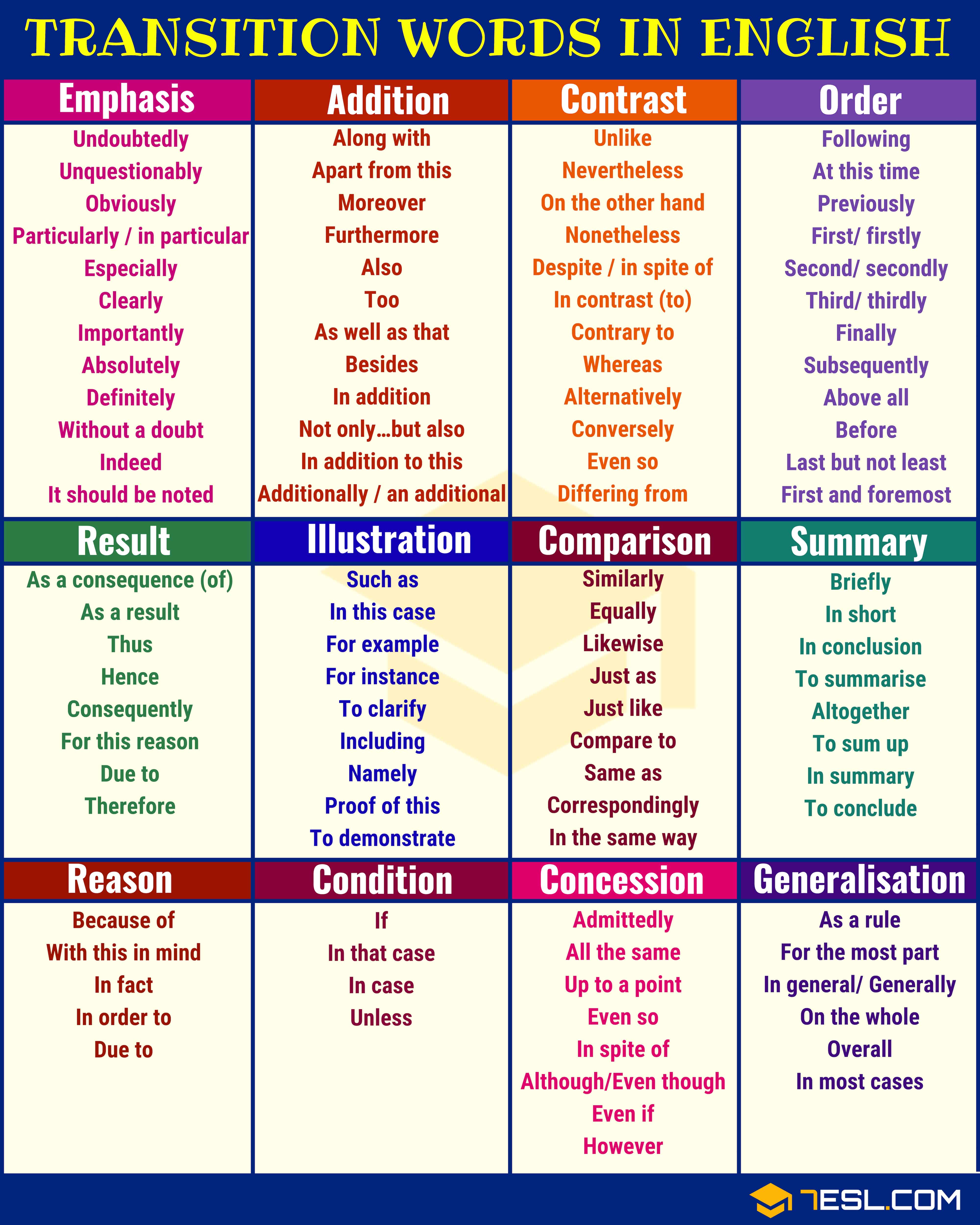W - Unit 9 - A2
How to Use Transitional Words in Paragraphs
Transitional words and phrases are crucial in writing as they help connect ideas, improve the flow of text, and enhance the coherence of your arguments. They act as bridges between sentences and paragraphs, guiding the reader through your writing. Here’s a comprehensive guide on using transitional words effectively, including examples, correct punctuation, and placement in sentences.
1. Addition
Purpose: To add information or ideas.
Examples:
- Furthermore: Used to introduce an additional point.
- Example: "She loves reading novels. Furthermore, she enjoys writing short stories."
- Moreover: Similar to “furthermore,” it adds more detail to support the previous statement.
- Example: "The new policy improved employee satisfaction. Moreover, it led to increased productivity."
- Additionally: Used to provide more information.
- Example: "The project requires extensive research. Additionally, it demands thorough analysis."
Punctuation: Usually followed by a comma.
- Example: "He completed his assignment. Additionally, he reviewed it for errors."
Placement: Typically at the beginning of a sentence or clause.
2. Contrast
Purpose: To show differences or contrasts between ideas.
Examples:
- However: Indicates a contrast or contradiction.
- Example: "The new system is efficient. However, it is quite expensive."
- On the other hand: Used to present an opposing viewpoint.
- Example: "The policy benefits many employees. On the other hand, it may increase costs for the company."
- Nevertheless: Shows a concession or contrast.
- Example: "The exam was challenging. Nevertheless, she passed with flying colors."
Punctuation: Typically followed by a comma.
- Example: "He was tired. However, he continued working."
Placement: Usually at the beginning of a sentence or clause, but can also be used mid-sentence.
3. Cause and Effect
Purpose: To explain reasons, results, or consequences.
Examples:
- Therefore: Indicates a logical conclusion or result.
- Example: "The weather was severe. Therefore, the event was canceled."
- As a result: Shows the outcome of a preceding action.
- Example: "She missed the meeting. As a result, she was not updated on the latest changes."
- Consequently: Similar to "therefore," it shows an effect.
- Example: "He didn't follow the instructions. Consequently, the project failed."
Punctuation: Typically followed by a comma.
- Example: "She studied hard for the test. Therefore, she passed with high marks."
Placement: Usually at the beginning of a sentence or clause.
4. Comparison
Purpose: To show similarities between ideas.
Examples:
- Similarly: Indicates a similarity or parallel.
- Example: "The northern region has mild winters. Similarly, the southern region experiences moderate temperatures."
- Likewise: Used to show a comparable situation.
- Example: "The company reduced its carbon footprint. Likewise, its competitors have taken similar measures."
Punctuation: Usually followed by a comma.
- Example: "He is an expert in his field. Similarly, his colleague is highly skilled."
Placement: Generally at the beginning of a sentence or clause.
5. Time and Sequence
Purpose: To indicate the order of events or steps.
Examples:
- First: Indicates the initial step or event.
- Example: "First, gather all necessary materials."
- Next: Shows the subsequent step in a sequence.
- Example: "Next, follow the instructions carefully."
- Finally: Indicates the last step or conclusion.
- Example: "Finally, submit your report."
Punctuation: Typically followed by a comma.
- Example: "First, we need to plan the project. Next, we will assign tasks."
Placement: Usually at the beginning of a sentence or clause.
6. Emphasis
Purpose: To highlight or emphasize a point.
Examples:
- Indeed: Used to stress the truth or importance of a statement.
- Example: "The proposal was well-received. Indeed, it exceeded expectations."
- In fact: Provides a stronger assertion or clarification.
- Example: "He is a talented musician. In fact, he won several awards."
Punctuation: Usually followed by a comma.
- Example: "The new strategy is effective. Indeed, it has improved sales."
Placement: Often at the beginning or mid-sentence.
General Tips for Using Transitional Words:
- Consistency: Ensure that the transitional word aligns with the relationship between the ideas.
- Punctuation: Use commas after transitional words if they appear at the beginning of a sentence or clause.
- Avoid Overuse: While transitional words are helpful, excessive use can make writing seem repetitive. Use them judiciously.
- Placement: Transitional words can appear at the beginning of sentences, in the middle of sentences, or at the end, depending on the flow of the text.
By integrating transitional words effectively, your writing will flow more smoothly and your arguments will be clearer and more cohesive.
